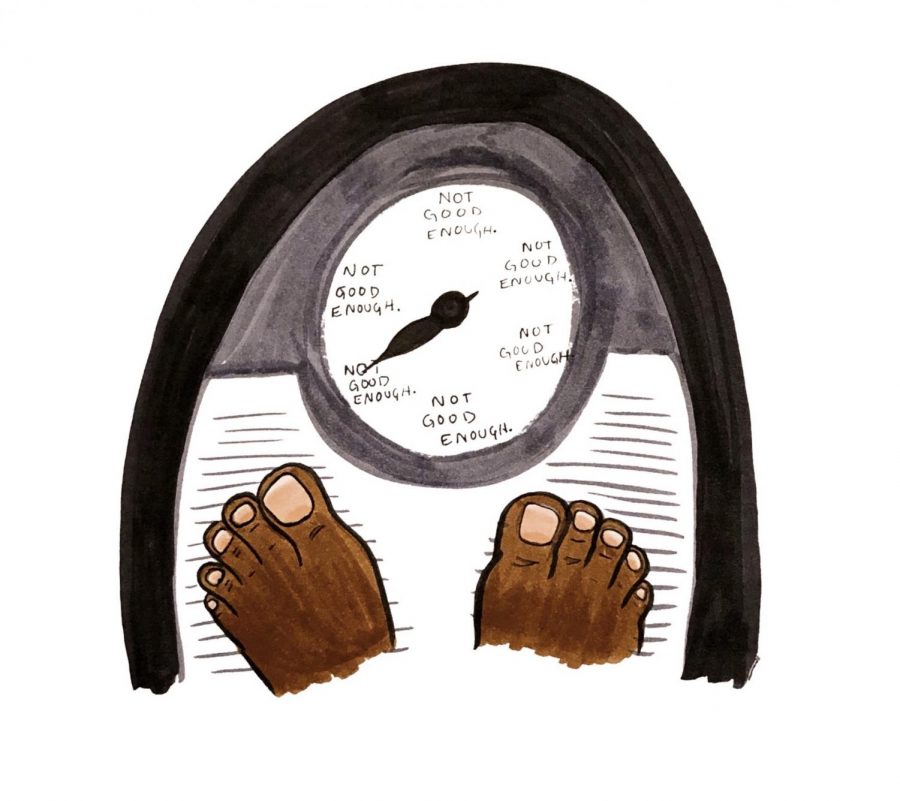“Just Eat”
The Truth about Eating Disorders
The reason that most people struggle with eating disorders for so long before they’re discovered is that the symptoms are often hidden to others.
January 28, 2019
I want to preface this article by saying that it was extremely difficult to write — not because of complexity or the amount of quotes I had to get or the amount of time I put into writing it, but because it was so personal.
As a person who has struggled with multiple eating disorders, I pushed myself really hard to conduct the research and obtain the testimonials below. I wanted to write this so that any girl or guy here can see that they’re not alone in the school or in the world.
If you currently struggle with an eating disorder, it might be best to not read this article, because it can be triggering; however, you might want to read at least some of it so you know the true effects of eating disorders.
When people think about eating disorders, they typically picture a very frail teenage girl. This is a common misconception. While many anorexics are extremely underweight, many others with anorexia, as well as people with bulimia or binge-eating disorders, can have average or even high body weights.
Additionally, according to the National Eating Disorders Association, around 14 percent of people with eating disorders are men, disproving the notion that only girls are affected. Another common misconception is that an eating disorder is only a mental condition. Every eating disorder has long term effects on your body, an eating disorder often correlates with depression, anxiety, and suicidal thoughts.
With anorexia, a person can experience hair loss, lanugo, and organ failure. Bulimia can cause all the same symptoms along with enamel decay, intestinal and stomach damage, and permanent throat damage. Binge-eating disorder can cause diabetes, obesity, lethargy, organ malfunction, sleep apnea, high blood pressure, heart disease, and muscle and joint pain.
The reason that most people struggle with eating disorders for so long before they’re discovered is that the symptoms are often hidden to others. Women and men who struggle with eating disorders make food and throw it out after family members have seen them make it, hide their binges and purges, binge at night, work extra hours so they can not eat and say they ate at work, and the list goes on.
Although an estimated 8 million Americans have an eating disorder, only 1 in 10 receive treatment, according to a statement from the Center for Overcoming Problem Eating (COPE). Treatment can range from $500 to $2500 a day, and the average cost for a month-long inpatient stay is $30,000. Even with all this money spent, which is often not covered by insurance without the mental health loophole, 80% of people treated do not receive the level of intensity or time needed for recovery. Most people in eating disorder recovery leave treatment weeks or even months before they should. 95% of people who leave eating disorder recovery early relapse within the first month of being released, also according to COPE.
Eating disorders have the highest mortality rate of any mental illness. According to research by NAANAD, 5 to 10 percent of anorexics die within 10 years of first showing symptoms; 20 percent of anorexics will die in 20 years and only 30 to 40 percent of anorexics will fully recover.
In a statement from the National Institute of Mental Health, just 10 percent of eating disordered people receive treatment. Then, out of that 10 percent, 80 percent leave treatment early. So, only 2 percent receive the level of care they need to not relapse. These statistics prove that the people who truly need treatment are simply not getting it.
****
I sat down with Student Assistance Coordinator Mr. Longo to ask him a few questions about eating disorders in high school students:
What is the most common misconception about eating disorders that you see as a professional who works with young adults ?
That they aren’t real, or that folks are looking for attention. A lot of people think of just anorexia and not the other eating disorders — bulimia and such. Many people don’t see the medical condition that an eating disorder is. You can’t just tell them to shove food in their face and just eat, it’s much more complicated than that.
What makes an eating disorder so hard to diagnose?
A person who has an eating disorder often has a hard time admitting it to themselves. Shame and stigma make it less likely to talk to their parents — either the sufferer thinks the parents don’t understand what’s going on, or they actually don’t. Eating disorders are hard to diagnose. A quote that really explains this is “you’re as sick as your secrets.” Someone who hides their symptoms makes the symptoms invisible — and you can’t diagnose something based on invisible symptoms.
How has the number of teenagers with eating disorders increased in the years you’ve been at NA?
I suspect it has increased, but whether or not is has, I’ve been more aware. It comes to light more often now, especially with increased stress and anxiety.
****
The main three types of eating disorders are anorexia, bulimia, and binge-eating disorder.
Anorexia Nervosa is characterized by extreme fasting, eating little to no food, and exercising off any possible calories consumed in the day. Anorexics also have an intense fear of becoming overweight or fat, extreme dissatisfaction with the way they look, and denial to see how underweight they truly are. (if they are underweight- anorexia can and will affect people of average/high weight- this is known as atypical anorexia)
Bulimia Nervosa is trickier to diagnose. There are 2 main possible symptom groups to diagnose bulimia with. One way bulimia is diagnosed by binging large amounts of food and then purging using methods such as forcing oneself to vomit, using laxatives, and/or diet pills. The other way it is diagnosed when someone doesn’t binge, they just use methods of purging after eating “normal” amounts of food.
Binge-eating disorder is characterized by episodes of eating without a sense of control. A person with BED can use food as a comfort or as a coping mechanism to distract from other problems. BED can cause someone to eat until they physically cannot eat anymore, followed by extreme guilt or sadness.
****
Finally, I asked some of our peers here at NASH who have struggled with eating disorders in the past a few questions to show the similarities and differences from person to person. The interviewees asked to remain anonymous.
What eating disorder did or do you have?
Anorexia nervosa
How old were you when you started to develop symptoms of your eating disorder?
11
How big of a role in your life does body image play?
Now I think I’m too skinny and I try to eat more, but depression plays a large role in my appetite.
How big of a role in your life did body image play?
It used to not matter to me, but when I turned 11 when it started, it got worse. Then it got worse in middle school, and even worse in high school- it became everything to me. The way other people saw me destroyed me. Getting into relationships made it worse too- I felt like I needed to fit this perfect image of what a guy likes.
****
What eating disorder did or do you have?
Anorexia and bulimia
How old were you when you started to develop symptoms of your eating disorder?
I started having body image issues around when I was 11 in 5th grade but it didn’t evolve into an eating disorder until about 7th grade. At that time I started restricting my food pretty heavily and by 8th grade I was restricting but not as heavily as I used to. I started to put weight back on and it freaked me out so I started purging the food I ate.
How big of a role in your life does body image play?
It still plays a role in my life but not as big of a role as it used to.
How much of a role did it play?
It was everything. All I thought about was how to lose more weight as fast as I could. I would obsess over food. I’d go home and watch cooking videos for hours. I was so focused on food it was all I thought about. It affected my school work too. I would spend more time calculating the calories burned in an individual sit-up or each hour of cardio than I would on my homework and studying. My depression got worse too, as well as my anxiety. 8th grade through 10th grade was the worst years of my life. I would stare at my stomach and legs in the mirror for hours and cry. It was awful.
****
What eating disorder did or do you have?
I had anorexia
How old were you when you started to develop symptoms of your eating disorder?
I was 12
How big of a role in your life does body image play?
Body image plays a huge role in my life still, but i’ve come a long way over the years. I am so much happier with myself and i am learning to love the way I am.
How much of a role did it play?
It used to play an even bigger roll in my life than it currently does. I was always comparing myself to other people and wishing i was like them so badly. But i realized that i am unique and i should be happy in my own skin.
****
And that’s the truth about eating disorders. It’s not an easy fix — it’s not as simple and telling someone to “just eat” or “just stop binging,” because it doesn’t work like that. It’s a painful mental and physical condition and I hope you understand even a little bit more now.
If you or someone you know know is going through eating disorder symptoms right now, here are some resources you can use:
National Eating Disorder Association Website: https://www.nationaleatingdisorders.org
National Eating Disorder Association helpline: (800) 931-2237
The Emily Program helpline: (866) 821-0281
Crisis Text Hotline: text HOME to 741741














